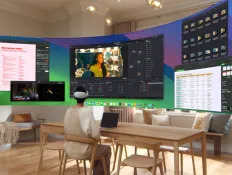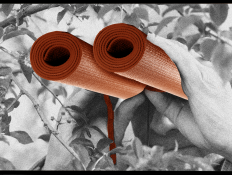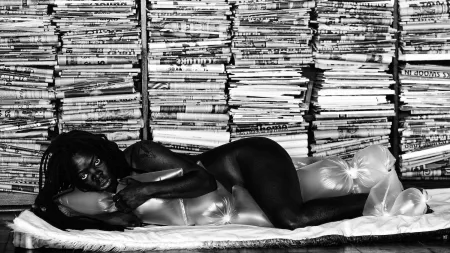
Among the personas photographer Zanele Muholi adopts in their self-portraits, two defining features tie the images to the artist: their darkened skin tone and the brightness of their eyes. Myriad details distinguish the various characters Muholi inhabits within the frame, but these two contrasting elements sear the artist indelibly into the mind of the viewer. Muholi immediately draws us into the worlds they create; they are spaces that defy binaries and traverse margins. But it’s when Muholi directs their gaze toward others that the mission of their work comes into full focus. By engaging their subjects and empowering them to tell their own stories, the work becomes more than an affirmation of presence; it is a place of healing.
Muholi has conducted her explorations of visibility during the span of a 20-year career that was examined in the recent show, “Eye Me” at the San Francisco Museum of Modern Art, and is the subject of an expansive encore presentation of a major survey at the Tate Modern in London (through January 26, 2025). Both shows present a portrait of an artist as a shapeshifter whose eye, material focus, and purpose have evolved alongside the images themselves. The Tate show in particular illuminates the experiences, influences, history, and social dynamics that inform Muholi’s artistic vision.
”Zanele Muholi” premiered at Tate Modern, London, on November 5, 2020. It subsequently traveled to Gropius Bau, Berlin (November 26, 2021 to March 13, 2022); Institut Valencià d’Art Modern (IVAM) (April 6, 2022 to September 4, 2022); and the Maison Européenne de la Photographie, Paris (February 1, 2023 to May 21, 2023). This iteration of the original show includes new photographic and sculptural works.
-
Early work

Image Credit: Copyright © Zanele Muholi. Courtesy of the artist and Yancey Richardson, New York. Born in 1972 and raised in Durban within the KwaZulu-Natal province of South Africa, Muholi came of age during apartheid, a witness to decades of violence and oppression and the subsequent adoption of a new constitution under the leadership of Nelson Mandela. This era ushered in a wave of restorative justice policies that prioritized dignity, equality, and human rights. However, despite these radically progressive tenets, systemic inequities persisted, with a particularly insidious backlash against LGBTQIA+ communities, resulting in violence and erasure.
Muholi began to study photography in 2001, working under the tutelage and mentorship of South African photographer David Goldblatt and his Market Photo Workshop. At the time there was a narrow visual register of artistic and photographic expressions of gender and sexual orientation, and Muholi, recognizing an urgent need for greater visibility, turned to visual activism while also radically repositioning the way images are constructed.
Their first series, titled “Only Half the Picture” (2002–2006), features subjects who survived violent hate crimes. In ID Crisis (2003) Muholi features a young person wrapping their breasts with an ace bandage, their face caressed by filtered sunlight coming through a window. The frayed edges of the bandage hint at a long-standing ritual, and the image asks: Is this a form of expression or protection? Satin athletic shorts and the subject’s hand placement are reminiscent of a boxer preparing for a fight, wrapping their hands and wrists before donning gloves. Despite this, there is a quietude and tenderness to the picture. Here, Muholi introduces a visual register in which two powerful forces exist within the same moment.
-
The “Being” series

Image Credit: Copyright © Zanele Muholi. Courtesy of the artist and Yancey Richardson, New York. Through their first series Muholi gave a visual language to trauma while remaining conscious of the delicate balance between acknowledging lived experiences and resisting being defined by them. In Muholi’s “Being” series (2006–ongoing), the artist celebrates intimacy between lovers in depictions of daily life that untether queerness from otherness. As writer Candice Jansen suggests in an essay titled “The Queer Spectacular” from the 2020–2021 Tate exhibition catalog, Muholi engages in “a ritual that queers visibility by surfacing gender and sexuality in exteriorising ways. The exterior can be the interior made visible.” In these photographs, subjects are photographed mid-embrace, their entwined limbs, clasped hands, and shared smiles both mirroring and radiating love.
-
The subject as participant

Image Credit: Copyright © Zanele Muholi. Courtesy of the artist and Yancey Richardson, New York. Muholi calls their subjects “participants,” an intentional distinction that eliminates any sense of detachment between the photographer and the sitter; instead, they are conspirators and coauthors in the narrative contained within the image. Two distinct series bring the stories of Muholi’s participants to life through their incisive accounts of violence. In the mid aughts Muholi created “Faces and Phases” (2006–ongoing), a series of works dedicated to Black trans women and nonbinary communities. These photographs feature individuals at moments of candor and self-possession, claiming space for their lived experiences.
In the Tate exhibition catalog, a portrait of Lungile Dladla is accompanied by her horrific account of a brutal “corrective” rape—a hate crime whose perpetrators disproportionately target Black, lesbian, and trans men and women with the express intent to instill fear and reinforce heteronormative values. In recounting the story and looking at their portrait, Dladla manages to cut through the heaviness with a simple transformative statement: “I am not a Victim, but a Victor.”
Likewise, proclamations of presence are manifested in a powerful array of photographs grouped in the Tate exhibit under the title “Queering Public Space.” In an interview with art scholar Katarina Pierre, Muholi asserted that visual activism is “a mode of survival. There are real, urgent issues at hand,” they said. “My community is directly connected to all the work I do, so, for me to have a show, being invited to exhibit my work at a gallery or museum, as a Black queer person, means that I have the opportunity to also mobilize members of the community to share that space and see themselves in it.”
In this group of photos we see participants emphatically claiming space with confident stances and defiant gazes as onlookers remain out of focus, their blurred presence relegated to the margins of the image. “These photographs are a way for the artist to position the Black queer body within spaces that have been historically unwelcoming to them,” says Tate curator Carine Harmand. Here Muholi abandons black-and-white photography and presents images that are awash in vibrant color. If Muholi’s black-and-white portraits seize the breath, these colorful portraits invite a long, triumphant exhalation.
-
“Somnyama Ngonyama”

Image Credit: Copyright © Zanele Muholi. Courtesy of the artist and Yancey Richardson, New York. Muholi’s 2016 self-portrait titled Phaphama (2016) is emblematic of their entry into a new phase of introspection. For the work, Muholi donned a black suit and bow tie with a crisp white shirt and sported a crown of hair hovering over their head like a dark cumulus cloud. The Zulu term phaphama translates to English as “awakening” or “revival,” and in the portrait Muholi is awakening their inner spirit. Phaphama is the queered, feminist coda to Kerry James Marshall’s ode to Blackness, Portrait of the Artist as a Shadow of His Former Self (1980).
Paphama is part of the series “Somnyama Ngonyama,” a photographic study of skin color, fluidity, and identity. The series title, which translates from Zulu to “Hail the Dark Lioness,” serves as both an introduction and a command to respect; in the Tate exhibition these high-contrast self-portraits accentuate Muholi’s digitally darkened skin and the whites of their eyes, which seem to bore into the viewer. Objects like clothespins, vacuum tubing, and tin cans are enlisted to create the personas Muholi adopts, as well as recall personal experiences and pivotal moments of political violence.
In another image in the series, Basizeni XL (2016), for example, the artist wears a necklace and headpiece made from bicycle tires. The use of tires references the apartheid-era practice of “necklacing,” a form of public execution in which pro-apartheid conspirators were immobilized with tires pushed down around their bodies, doused in gasoline, and lit on fire. In this image, whose title translates as “Help Them,” Muholi’s gaze is cast downward, a departure from the direct stare featured in other works in the series.
-
Monuments of existence

Image Credit: Copyright © Tate (Larina Fernandes). Both the exhibitions San Francisco and London exhibitions debuted sculptural works that harmonize with the rest of Muholi’s oeuvre. “The sculptures in the exhibition explore themes of intimacy and reckon with the relationship between public and private spheres,” says the Tate’s Harmand. “Through them we are presenting to the public a new facet of Muholi’s work and new areas of exploration for the artist.” While many of Muholi’s more recent projects appear to move away from an active engagement with trauma, we also see the artist’s process of working through pain. In the Tate exhibition a bronze sculpture of Muholi lies at the center of the “Queering Public Space,” gallery, their body resting peacefully on its side, surrounded by portraits of transgender women, gay men and gender non-conforming people photographed on beaches and other public places. “The use of bronze, a popular material for public sculpture, makes this piece a lasting monument to stillness and self-preservation,” notes Harmand.
Early work

Born in 1972 and raised in Durban within the KwaZulu-Natal province of South Africa, Muholi came of age during apartheid, a witness to decades of violence and oppression and the subsequent adoption of a new constitution under the leadership of Nelson Mandela. This era ushered in a wave of restorative justice policies that prioritized dignity, equality, and human rights. However, despite these radically progressive tenets, systemic inequities persisted, with a particularly insidious backlash against LGBTQIA+ communities, resulting in violence and erasure.
Muholi began to study photography in 2001, working under the tutelage and mentorship of South African photographer David Goldblatt and his Market Photo Workshop. At the time there was a narrow visual register of artistic and photographic expressions of gender and sexual orientation, and Muholi, recognizing an urgent need for greater visibility, turned to visual activism while also radically repositioning the way images are constructed.
Their first series, titled “Only Half the Picture” (2002–2006), features subjects who survived violent hate crimes. In ID Crisis (2003) Muholi features a young person wrapping their breasts with an ace bandage, their face caressed by filtered sunlight coming through a window. The frayed edges of the bandage hint at a long-standing ritual, and the image asks: Is this a form of expression or protection? Satin athletic shorts and the subject’s hand placement are reminiscent of a boxer preparing for a fight, wrapping their hands and wrists before donning gloves. Despite this, there is a quietude and tenderness to the picture. Here, Muholi introduces a visual register in which two powerful forces exist within the same moment.
The “Being” series

Through their first series Muholi gave a visual language to trauma while remaining conscious of the delicate balance between acknowledging lived experiences and resisting being defined by them. In Muholi’s “Being” series (2006–ongoing), the artist celebrates intimacy between lovers in depictions of daily life that untether queerness from otherness. As writer Candice Jansen suggests in an essay titled “The Queer Spectacular” from the 2020–2021 Tate exhibition catalog, Muholi engages in “a ritual that queers visibility by surfacing gender and sexuality in exteriorising ways. The exterior can be the interior made visible.” In these photographs, subjects are photographed mid-embrace, their entwined limbs, clasped hands, and shared smiles both mirroring and radiating love.
The subject as participant

Muholi calls their subjects “participants,” an intentional distinction that eliminates any sense of detachment between the photographer and the sitter; instead, they are conspirators and coauthors in the narrative contained within the image. Two distinct series bring the stories of Muholi’s participants to life through their incisive accounts of violence. In the mid aughts Muholi created “Faces and Phases” (2006–ongoing), a series of works dedicated to Black trans women and nonbinary communities. These photographs feature individuals at moments of candor and self-possession, claiming space for their lived experiences.
In the Tate exhibition catalog, a portrait of Lungile Dladla is accompanied by her horrific account of a brutal “corrective” rape—a hate crime whose perpetrators disproportionately target Black, lesbian, and trans men and women with the express intent to instill fear and reinforce heteronormative values. In recounting the story and looking at their portrait, Dladla manages to cut through the heaviness with a simple transformative statement: “I am not a Victim, but a Victor.”
Likewise, proclamations of presence are manifested in a powerful array of photographs grouped in the Tate exhibit under the title “Queering Public Space.” In an interview with art scholar Katarina Pierre, Muholi asserted that visual activism is “a mode of survival. There are real, urgent issues at hand,” they said. “My community is directly connected to all the work I do, so, for me to have a show, being invited to exhibit my work at a gallery or museum, as a Black queer person, means that I have the opportunity to also mobilize members of the community to share that space and see themselves in it.”
In this group of photos we see participants emphatically claiming space with confident stances and defiant gazes as onlookers remain out of focus, their blurred presence relegated to the margins of the image. “These photographs are a way for the artist to position the Black queer body within spaces that have been historically unwelcoming to them,” says Tate curator Carine Harmand. Here Muholi abandons black-and-white photography and presents images that are awash in vibrant color. If Muholi’s black-and-white portraits seize the breath, these colorful portraits invite a long, triumphant exhalation.
“Somnyama Ngonyama”

Muholi’s 2016 self-portrait titled Phaphama (2016) is emblematic of their entry into a new phase of introspection. For the work, Muholi donned a black suit and bow tie with a crisp white shirt and sported a crown of hair hovering over their head like a dark cumulus cloud. The Zulu term phaphama translates to English as “awakening” or “revival,” and in the portrait Muholi is awakening their inner spirit. Phaphama is the queered, feminist coda to Kerry James Marshall’s ode to Blackness, Portrait of the Artist as a Shadow of His Former Self (1980).
Paphama is part of the series “Somnyama Ngonyama,” a photographic study of skin color, fluidity, and identity. The series title, which translates from Zulu to “Hail the Dark Lioness,” serves as both an introduction and a command to respect; in the Tate exhibition these high-contrast self-portraits accentuate Muholi’s digitally darkened skin and the whites of their eyes, which seem to bore into the viewer. Objects like clothespins, vacuum tubing, and tin cans are enlisted to create the personas Muholi adopts, as well as recall personal experiences and pivotal moments of political violence.
In another image in the series, Basizeni XL (2016), for example, the artist wears a necklace and headpiece made from bicycle tires. The use of tires references the apartheid-era practice of “necklacing,” a form of public execution in which pro-apartheid conspirators were immobilized with tires pushed down around their bodies, doused in gasoline, and lit on fire. In this image, whose title translates as “Help Them,” Muholi’s gaze is cast downward, a departure from the direct stare featured in other works in the series.
Monuments of existence

Both the exhibitions San Francisco and London exhibitions debuted sculptural works that harmonize with the rest of Muholi’s oeuvre. “The sculptures in the exhibition explore themes of intimacy and reckon with the relationship between public and private spheres,” says the Tate’s Harmand. “Through them we are presenting to the public a new facet of Muholi’s work and new areas of exploration for the artist.” While many of Muholi’s more recent projects appear to move away from an active engagement with trauma, we also see the artist’s process of working through pain. In the Tate exhibition a bronze sculpture of Muholi lies at the center of the “Queering Public Space,” gallery, their body resting peacefully on its side, surrounded by portraits of transgender women, gay men and gender non-conforming people photographed on beaches and other public places. “The use of bronze, a popular material for public sculpture, makes this piece a lasting monument to stillness and self-preservation,” notes Harmand.

Car of the Week: An Ultra-Rare 2013 AC Zagato Supercar Is up for Grabs

How Retailers Can Better Navigate Pricing Pressures This Holiday Season

One new Apple Vision Pro feature can finally unlock its true potential

Industry Convenes at Nasdaq for Sportico’s ‘Invest in Sports’


